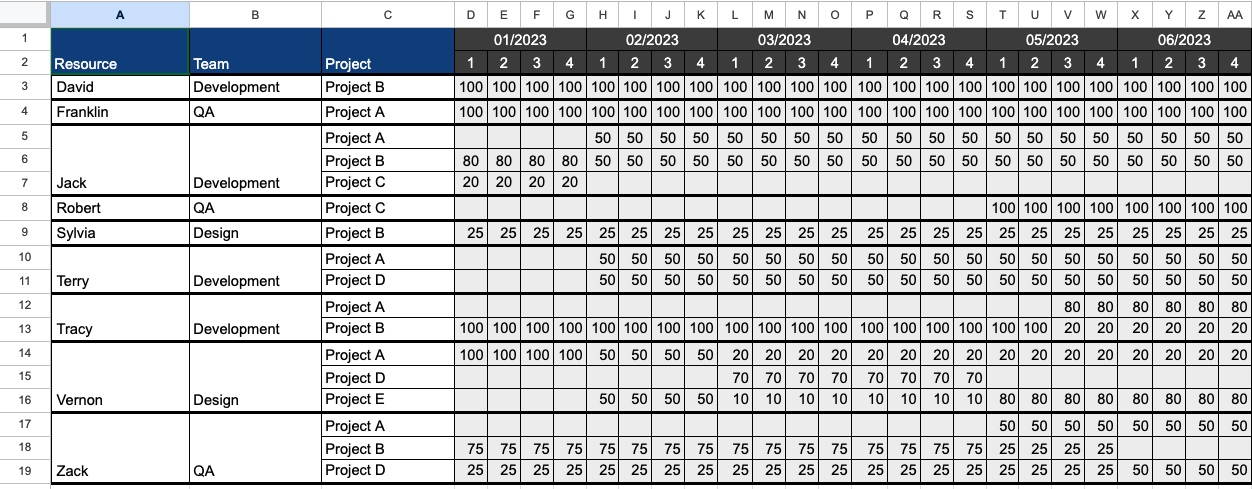Someone’s sitting in the shade today because someone planted a tree long ago. – Warren Buffett
We can easily relate this quote to our topic by asking ourselves: Why is Resource Planning important, and how can a well-prepared Resource Plan prevent many project issues later on?
By saying resources in IT we are mostly talking about:
- Effort that an individual invests
- Money
- Time
- Physical Equipment
- Services
In this article, we will discuss human resources and their efforts and compare the other resources to the importance of resource planning. Let’s dive deeper and learn more about Resource Planning from PM’s perspective.
Resource planning: How complex can it be?
The pinnacle of Resource Planning complexity resides at the highest echelon within the company’s hierarchy, serving as the origin for most of the organization’s plans. Resource Planning of a more straightforward nature involves allocating resources exclusively for a particular project.
In that case, Project Managers, who are responsible for project resources, are mostly handling the resources just on that specific project with less focus on other projects or teams. Since it is most demanding to plan resources if they are shared among several projects, the goal is to focus on one project at a time.
We need to have an accurate, well-made plan for those resources and keep the resource plan updated daily or at least weekly.
The relationship between overload and freedom
Every person in charge of planning and allocating resources strives to optimize the amount of resource load. Why is it so important? If we make a bad ratio between time and effort and give a resource too much load for some period, there is an easy chance that burnout is coming.
For example, if we give developers many tasks for a short period, they can easily quit. This leaves us with an empty resource space that we need to fulfill, which is mostly very expensive. Likewise, if we don’t give developers enough tasks, they could become unmotivated and quit.
There is a well-known term related to the burden on human resources, and that is burnout. Burnout is a state of human resources where the resource mostly has too much pressure on the work or doesn’t even have the right amount of appreciation for the work done to keep up with demand. Burnout can manifest from a lack of a reward or just appreciation for their efforts.
The latest research shows that over 60% of people in the IT industry sometimes experience burnout during their professional career, and even a quarter of employees experience burnout often or always.

How to avoid burnout 2023?
A few recommended approaches to avoid project burnout artwork:
Set a focus on the result, not the process
If the focus during work is exclusively on the process, it often seems to the employee that the task will never end. That’s why it’s better to focus on the result of completing the task, easily monitor progress, and thus be more motivated.
Try not to work overtime
No one likes working under conditions exceeding what the employer has contractually agreed upon. When there’s a need for additional (overtime) hours, it is necessary to explicitly decide on a reward with the resources or at least motivate them to see the benefit of that overtime work. Certainly, overtime work must be the decision of the individual asked to do so.
Chop the tasks into smaller pieces
Large tasks (especially ones with significant estimates that are publicly available) are usually a flawed approach for the individual and the manager because it is difficult to monitor the progress. Also, to stay motivated, the developer must divide the tasks into smaller units to follow them quickly and ensure the job is always in sight.
React to the unreasonable requests
Don’t be a sheep! When planning tasks for a certain next period with the manager, it is necessary to understand each assignment. Once we know these tasks, we must assess whether any requested assignments are unreasonable. If they are, we must proactively address the issue and establish a well-founded position, supporting it with compelling arguments. This approach will benefit us and contribute to the success of the entire project we are working on.
Extra tips for avoiding burnout: listen to your body, meditate, exercise, have a good diet, go on vacation, and talk to your loved ones about your problems or, at least, tell them to listen to you to make it easier. Also, one of the best solutions to help relax is to reduce the amount of caffeine intake in your body. Most people working in IT are heavy caffeine addicts and are unaware of it.
How do we track resource availability?
Many tools make Resource planning much easier, but Resource Managers decide the best approach for themselves to make the planning most efficient.
The most common tool is the resource calendar. The resource calendar can be a simple MS Excel table in which all the resources and their availability capacity are written.

The example above shows an example of the resource plan for the first six months of 2023. It is important to note that the mentioned plan was made for resource planning at the company level, not the project level. Every resource should be utilized 100% at all times. Otherwise, we have an idle resource. Get the free Resource Calendar Template.
What is the most important project Resource?
Defining the most essential resource is challenging since each resource type has a different weight in different project situations. Most people say that the most important resource is money.
For example, imagine you’re working on a project that has been going on for five years, and everything seems great. Suddenly, you need to spend your budget (because it was not foreseen in the discovery phase) on a license to continue developing your product. If that is your company’s main project, you will use that budget to keep the client satisfied and the whole project going.
5 main steps in Resource planning
Resource managers must prioritize the Resource planning process, whether they have other responsibilities. Here are five steps that are usually the most common in resource planning.
1. Check the status of all projects
At the beginning of resource planning, it is necessary to check the status of each currently active project in the company. We have to check the resource utilization plans by project, and only then do we move on to the next step, which is to find out the need for resources by project.
2. Find out the need for resources
Each project manager must have a clearly defined list of resources described with the amount and period of demand for the same.
3. Resources procurement
Once the resources for which there is a need are clearly defined, it is necessary to acquire them. This is why it is essential to procure resources promptly and not at the last minute. In the process of acquiring resources, we use various techniques to acquire them and make a schedule if necessary.
4. Create a resource schedule
In creating the resource schedule, all resources are defined by the project, and the total time spent by each project is defined.
Most often, the time spent is expressed in percentages or working hours to look like this: Person X works 8 hours daily. In 3 months, the employee will work on two projects at 50%. We have documented that this person will dedicate four hours daily to each project.
Given that each person must also have a break within those 8 hours, the availability is often reduced to get a realistic picture. That turns out to be 3.5 hours per day, enough for the project manager to know how to plan the project timeline according to the estimates.
5. Resource usage monitoring
The schedule of resources needs to be done well, but it needs to be refined as needed. The executive resource manager must continuously (weekly) monitor the use of resources and, if necessary, repeat the planning process from the beginning.
Sharing resources across projects
From the project manager’s point of view, resource planning is most demanding when it comes to sharing resources between multiple projects. Then it is necessary to be in sync with other project managers very often (even daily) so that each project achieves its goals without problems.
An example of sharing resources on projects:
Currently, Project A is in the Discovery phase, requiring the participation of the person assigned to the designer role. Meanwhile, on Project B, which is highly profitable for us, there is a need for a change request. So, it’s important to plan carefully and decide when to assign the designer to each project.
Resource planning benefits
Resource planning is an essential item in every IT company. Without resource planning, there is a very high chance that sometime in the future, we will encounter problems that can negatively impact the project that the resource affects or the entire company.
In general, the most prominent advantages of resource planning are:
- Time savings – so that a project delay never happens, and if we are within the defined deadline, saving time becomes a direct time profit.
- Cost savings – usually the most sensitive thing in business, allows us to use finances for other things in the company or on the project.
- Team collaboration enhancement – to reduce interpersonal problems and raise motivation among human resources.
- Reduced stress – an influential factor for the loss of resources creates a comfort zone in the company.
Takeaway
In conclusion, effective resource planning is the backbone of any successful project or organization. It is a strategic process that ensures IT organizations can effectively allocate and utilize their valuable assets, such as human resources, technology, and budget, to meet project demands and business objectives.
In the IT industry, resource planning goes beyond managing physical resources; it also involves working on the knowledge and expertise of the workforce. Understanding team members’ skill sets and capabilities enables organizations to assemble high-performing teams for specific projects, optimizing productivity and delivering exceptional results.
By implementing robust resource planning practices, IT companies can stay ahead of the competition, optimize their productivity, streamline operations, deliver projects on time and within budget, and foster a culture of innovation and collaboration.
Take charge of your business’s success – contact us today to optimize your projects and boost efficiency tomorrow.
